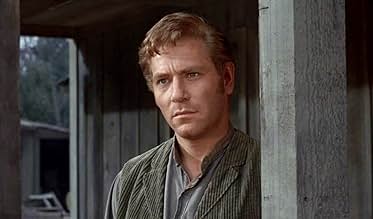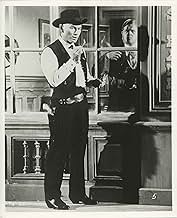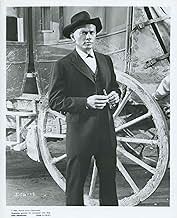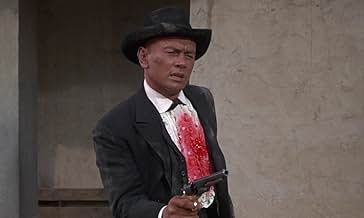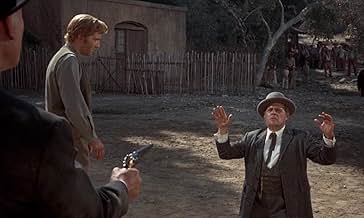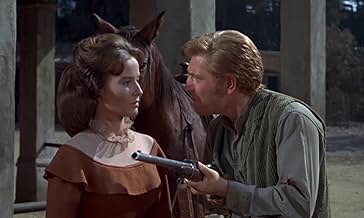Au Nouveau-Mexique, un vétéran confédéré rentre chez lui et retrouve sa fiancée mariée à un soldat de l'Union, ses voisins yankees ralliés contre lui et sa propriété vendue par le banquier l... Tout lireAu Nouveau-Mexique, un vétéran confédéré rentre chez lui et retrouve sa fiancée mariée à un soldat de l'Union, ses voisins yankees ralliés contre lui et sa propriété vendue par le banquier local qui engage alors un tireur pour le tuer.Au Nouveau-Mexique, un vétéran confédéré rentre chez lui et retrouve sa fiancée mariée à un soldat de l'Union, ses voisins yankees ralliés contre lui et sa propriété vendue par le banquier local qui engage alors un tireur pour le tuer.
- Réalisation
- Scénario
- Casting principal
- Manuel
- (as John Alonzo)
Avis à la une
The acting is all over the board in this one, as well. Brynner's performance can't be faulted; he's his usual simmering, silent presence, but seems miscast in a role which could have been quite interesting if it weren't so poorly-written. Janice Rule seems confused in her role as Ruth Adams (and well she should be, forced to serve as the love interest between--count them--three men, all trying to kill each other at some point or another), and spends most of it looking vaguely sad and disinterested, and Pat Hingle is neither evil enough nor serious enough to make a compelling villain. Clifford David fares better as the perpetually angry Crane, and George Segal, as the unfortunate Matt Weaver, is just about the only member of the cast that seems to have any idea what he's doing. The rest of the townsfolk are a mixture of clichés and stereotypes that make it seem as though Yul Brynner mistakenly wandered onto the set of "Blazing Saddles." Brynner's presence, and the multi-layered, operatic scale of the plot might warrant repeat viewings, and the film should be credited for trying to tackle weighty issues of morality and racism, but ultimately "Gunfighter" misses its mark. The classic mantra in storytelling is "show, don't tell," and this film doesn't do that, rendering what should have been a very good movie into a very mediocre one.
This is a tremendously exciting story of a gunfighter-for-hire who had only one more killing to go. It begins as a slow-moving Western but follows to surprise us with dark characters and solid plot ; resulting to be a striking piece. Long on dialog but contains an exciting final with surprising duel . The tale is almost grim , a killer comes to a town just in time to make sure its citizenry but later the events get worse . Short on action Western with Brynner as rare gunslinger who is hired as professional murderous to kill outcast Confederate George Segal. The highlights are the violent destruction of the town and the climatic showdown at the ending. Phenomenal and great role for Yul Brynner as avenger angel and bitter gunfighter, he's the whole show at the height of his iconic game . Vivid and lively musical score by David Raksin. Atmospheric cinematography in glimmer color by Joseph McDonald. The motion picture is professionally realized by Richard Wilson (Al Capone , Three in Attic). Wilson was a previous associate of Orson Welles in the Mercury Theatre days and made another good Western as ¨Man with a gun¨, starring Robert Mitchum and ¨Zane Grey¨ episodes. Watchable results for this offbeat Western.
This talky, awe-inspiringly pretentious 'adult' western (scripted by Wilson and his wife Elizabeth) that a few years earlier would have signalled it's seriousness by being in black & white (like 'High Noon' or '3:10 to Yuma') is instead shot in incongruously pretty colour by veteran cameraman Joe MacDonald on the Universal backlot, where Brynner later trashes the already flimsy-looking sets with suspicious ease.
Based on a 1957 TV play, it was made too early to be influenced by Sergio Leone, but was obviously influenced (as was Leone himself) by the samurai films of Kurosawa.
The cast was largely recruited from TV and the New York stage, some of whom - like George Segal and Strother Martin - became more familiar a few more years later; while David Raksin's woodwind score lingers in the memory.
Yul Brynner was a smoker, and the cigar is ever present. I met him in 1972 out in Malibu, and I asked him if he could quit smoking for his health's sake. He said, "Nope. Too hooked." He was, and sadly for his fans, it was his undoing. He signed a photo for me for my birthday that year, which I still cherish. The world lost a great actor when he passed. He was the best in a Western, wearing black and walking that walk...a man of few words.
Le saviez-vous
- AnecdotesThe Psychose (1960) house set on the Universal back lot was the home for the character "Sam Brewster".
- GaffesOne of the Union infantry veterans in the town wears crossed rifles on his kepi. But the cross rifles insignia was not adopted for infantry until after the Civil War. The crossed rifles are what infantry wore during the post Civil War Indian wars. Rather, infantry wore a bugle on their kepis or bummers cap, and as the year is 1865 and as this is a Union infantry veteran from the Civil War, he should be wearing the bugle insignia and not the crossed rifles insignia.
- Citations
Sam Brewster: Is your name Jewel?
Hotel Owner: The hotel register....
Jules Gaspard d'Estaing: My name is
[d'Estaing writes his name on a blackboard]
Sam Brewster: Jewels...Gasperd...Die-es-ting
Jules Gaspard d'Estaing: Jules...soft j, silent s...Gaspard...silent d...d'Estaing...just a touch of dipthong.
- Crédits fousOpening credits prologue: NEW MEXICO TERRITORY - 1865
- ConnexionsReferenced in Question d'honneur (1966)
Meilleurs choix
- How long is Invitation to a Gunfighter?Alimenté par Alexa
Détails
- Date de sortie
- Pays d’origine
- Langue
- Aussi connu sous le nom de
- Invitation to a Gunfighter
- Lieux de tournage
- Sociétés de production
- Voir plus de crédits d'entreprise sur IMDbPro
Box-office
- Budget
- 1 800 000 $US (estimé)
Contribuer à cette page



